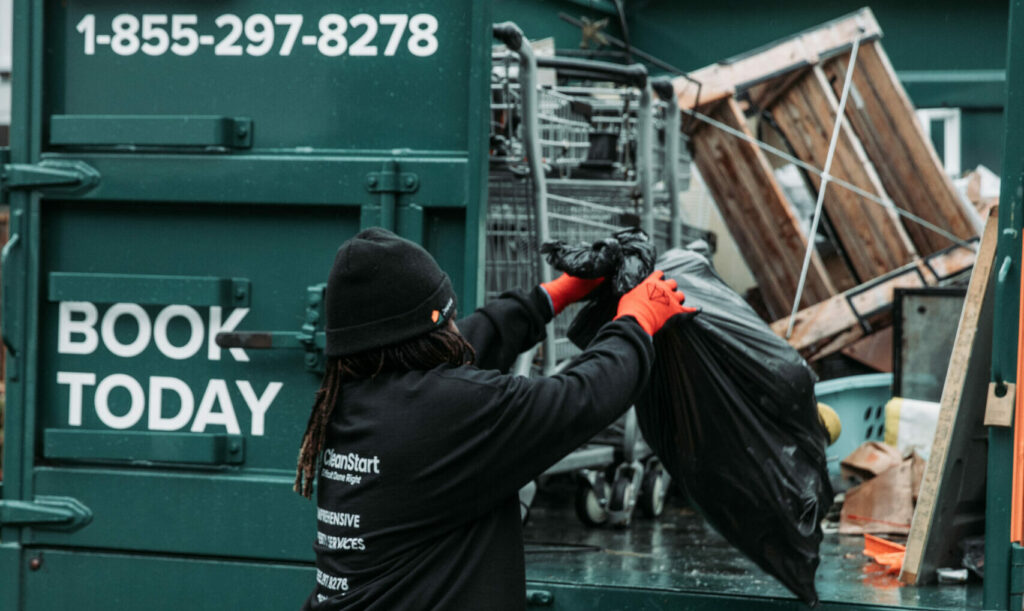5 De-Cluttering Tips for Hoarders

CleanStart Property Services has over 10 years of experience in junk removal and hoarding support in the Lower Mainland of British Columbia. We often receive inquiries for tips on de-cluttering extreme spaces. Our friends at Aspen Clean offer some great tips! You can find the full article here: https://www.aspenclean.com/en-ca/blogs/cleaning-tips/how-to-declutter-your-home-and-stop-hoarding
Hoarding is a compulsive mental disorder associated with a pattern of behavior that makes it extremely difficult for an individual to discard their possessions. It’s often emphasized by the excessive gathering of things, and a strong unwillingness to give them up, even when living spaces are filled to the brim. This commonly results in stress, impairment, and even personal safety can become a real issue. Compulsive hoarding is also considered a feature of obsessive-compulsive personality disorder (OCPD).
A good example of this habit is the popular television program Hoarders, wherein we’re continually shown the negative effects of the disorder on people’s lives, including how it contributes to family strife and tension, and the development of isolation and hermit-like qualities. Believe it or not, people can become prisoners in their own homes as a result of hoarding. While hoarding may stem from a number of psychological conditions and other societal and familial factors, the condition can be combated with the love and support of one’s family unit, as well as friends and support groups.
Our Best De-Cluttering Tips
Know your hoarding tendencies
Start small: 5 minutes at a time
Donate the clothes you don’t wear anymore
Focus on one room at a time: the bathroom is a good place to start
Ask for help: declutter living rooms with your family or your friends
How to Stop Hoarding Tendencies
If you think you may be developing a problem with hoarding, ask yourself why and how you’ve managed to accumulate so much stuff, and what purpose does it serve? Does all your stuff really make you happy, or are you beginning to realize that your home is just a storage facility for useless things? Does another object or possession fulfill the same purpose? How critical is this piece to your happiness?
Imagine seeing your space through the eyes of a friend. Would you be worried about yourself? Or would others agree that everything in your home serves an integral purpose?
The best way to combat the tendency to hoard is to constantly question, and keep tabs on, the behavior you observe in yourself, or committed by your family members or friends. Assess the potential for hoarding getting out of control – admittedly, we can all end up holding on to cherished mementos from our childhoods or from significant achievements – but when the level of importance begins to fade and inanimate object begin to pile up, the tendency to hard may be taking over.
In order to stop or prevent hoarding behavior, you need to be critically engaged in the actions you take part in. Let’s look, then, at some ways to easily and effectively counter hoarding:
Start Small
If you or one of your loved ones is a hoarder reaching out for help, one of the easiest ways to begin the healing process is to start small. Simply taking over someone’s house and throwing out all their things can be just as damaging as the effects of the disorder itself. Like other forms of mental illness, a slow and steady approach can be very beneficial to the process of reversing the need to hoard.
Start by making a routine of taking out the trash and recycling. This is helpful because it allows hoarders and their support groups to throw out even more trash as time goes on. The next steps can include how to tackle each room within the house from a trash standpoint – going one room at a time is often a comfortable way to begin the decluttering process for most hoarders. Assemble a house cleaning kit that you could use in various parts of the house.
As you begin the process, try starting with the kitchen. Leftover food, rotten food, and other organic products can pose certain health risks. A dirty kitchen also smells terrible, so cleaning and decluttering can bring about a sense of freshness and positivity. Tackle the sink by washing pots and pans, recycling old Tupperware containers that can’t be salvaged, and focus on removing potentially harmful bacteria and germs from the home. Make sure to use non-toxic dishwashing detergents for that. Next will be to do a thorough clear-out of the fridge. You’ll likely discover a plethora of expired and rotten food inside, so be sure to check for food that’s soon to expire as well. Once complete, we recommend slicing a lemon and placing it in the fridge to keep nasty odors at bay. Make sure you only use natural cleaning products, when cleaning your home.
How to Stop Hoarding Clothes?
Begin the decluttering process by starting with your laundry. Pile up clothing that is going to stay with you and form a separate pile of garments that can be washed and donated to a charity or organization. Wash everything with some natural, eco-friendly laundry detergent. When your clothes come out of the dryer, ask yourself critically if you’re ever going to wear them again – it’s best to do this with an impartial support person who can help you, or leave your hoarder friend/family member make these decisions.
Fold and put away all the clothes that you’ve decided to keep. Organize our closet in much the same way; and, as a way to combat negative feelings related to hoarding, remind yourself of the people you’ll be making happy when you donate your old clothes to charity. Try to associate decluttering with positive thoughts.
Bathroom
Throw out any old personal care products, or donate rarely used ones to someone who will benefit from them. Dispose of all leftover prescription medications that could fall into the wrong hands. Next comes the countertops, toilet, shower/bathtub, floors, and glass surfaces. Sanitation is of the utmost importance in the bathroom, as festering bacteria, feces, urine, and other things can present dire health concerns and should be cleaned as part of a regular cleaning routine. Resist the use of harsh chemicals, keeping in mind the environmental dangers of using toxic cleaners, and instead go for Eco-friendly bathroom cleaners with ingredients from natural sources like plants and minerals. They will clean your bathroom just as effectively, and leave you with a healthier, non-toxic home that will also benefit your health.
Living Space
Living rooms and recreational spaces are tricky ones, as this can be where most of the hoarding takes place. Things like mantelpieces and coffee tables can very quickly become covered in newspapers, magazines, and the like. Living spaces can be touchy places for people with hoarding tendencies, as these places are likely the most heavily populated areas of the home. Living rooms, therefore, can be home to some of the strongest emotions, most important pieces, and biggest perceived problems.
As always, decluttering and cleaning the space from top to bottom is task number one. If your floors are carpeted then consider bringing in a carpet steamer or professional cleaner to really get into the nitty-gritty of the material. Use shelves, totes, etc. to bring order to your space, and try to develop a system to see the value in your organization and cleanliness.
Hoarding may be a compulsive disorder, but it’s nothing to be ashamed of. Help yourself and others to realize that you’re not trying to single them out as ‘crazy,’ or ‘irrational’ for hoarding so much stuff away. Decluttering and solving a hoarding problem also isn’t about simply throwing everything out and adapting to a minimalist lifestyle. You’re entitled to hold onto things that you cherish, but adding a sensibility and dedication to cleaning and organizing your space can be hugely beneficial to correcting a damaging behavior.


